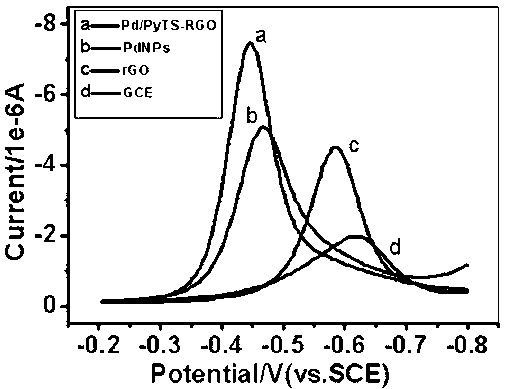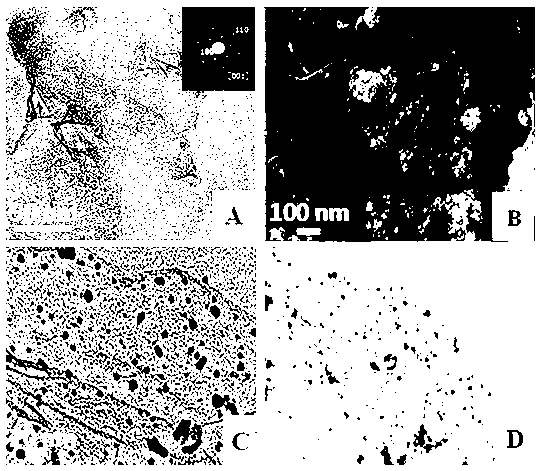Preparation method and use of functional graphene-loaded palladium nanoparticle composite material
A composite material, palladium nanotechnology, applied in the direction of material electrochemical variables, etc., can solve problems such as large overpotential oxygen interference, and achieve the effect of good stability, high sensitivity, and low detection line
- Summary
- Abstract
- Description
- Claims
- Application Information
AI Technical Summary
Problems solved by technology
Method used
Image
Examples
Embodiment 1
[0037] 1) The preparation process of graphene
[0038] a) Put 2g graphite powder into a 250mL beaker, add 1g NaNO 3 and 46mL 98%H2SO4, and stirred thoroughly in an ice-water bath.
[0039] b) Add 6 g of potassium permanganate to the above solution, keep the temperature of the whole system at 20° C. and stir for 5 minutes. Then remove the ice-water bath, heat to 35°C, and stir for 30 minutes.
[0040] c) Add 92mL of secondary water, heat to boiling (98°C) and stir for 15 minutes, then add 80mL of 3% hydrogen peroxide (the solution should be close to brown at this time, indicating that the graphite is oxidized).
[0041] d) Centrifuge the above solution at 7200 rpm for 30 minutes.
[0042] e) Wash the centrifuged powder with secondary water until the pH of the supernatant suspension is about 7.
[0043] f) Disperse the powder obtained from the above washing in water again and sonicate for 30 minutes (ultrasonic exfoliation).
[0044] g) After vacuum filtering the black resi...
PUM
| Property | Measurement | Unit |
|---|---|---|
| specific surface area | aaaaa | aaaaa |
Abstract
Description
Claims
Application Information
 Login to View More
Login to View More - R&D
- Intellectual Property
- Life Sciences
- Materials
- Tech Scout
- Unparalleled Data Quality
- Higher Quality Content
- 60% Fewer Hallucinations
Browse by: Latest US Patents, China's latest patents, Technical Efficacy Thesaurus, Application Domain, Technology Topic, Popular Technical Reports.
© 2025 PatSnap. All rights reserved.Legal|Privacy policy|Modern Slavery Act Transparency Statement|Sitemap|About US| Contact US: help@patsnap.com



